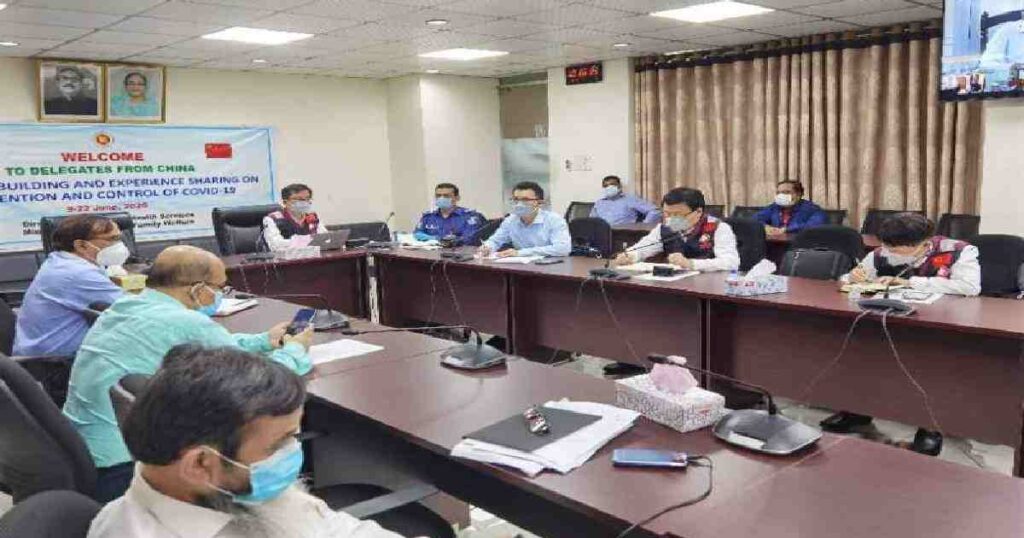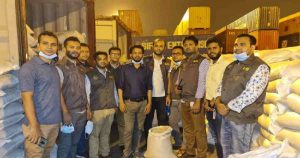Visiting Chinese medical experts have recommended increasing testing facilities in upazila-level here within the shortest possible time.
The Chinese medical experts team will submit a comprehensive report on their observations to the Health Minister before leaving Bangladesh.
In reply to a question related to rapid testing, a Chinese expert said that rapid test can not replace RT-PCR tests, but it could help diagnosis.
On the seventh day of Bangladesh visit, the team of Chinese medical experts held experience sharing sessions with top health professionals in division, district, and upazila levels through video conferencing from Directorate General of Health Services (DGHS), Dhaka, according to Chinese Embassy in Dhaka.
They joined in dialogue with the Director of Alternative Medical Care as well the experts from National Nutrition Services (NNS), Non Communicable Disease Control (NCDC) and Core Lab Groups in the same venue, and visited the Institute of Public Health (IPH).
The experts were accompanied by the Chinese Embassy officials.Dr. Sharmila Ferdaouse welcomed the team at the DGHS Conference Hall in the morning and moderated the session.
Dr. Afsana Alamgir, DPM, CDC, DGHS gave a presentation on the overall healthcare system of Bangladesh. Joining via video conferencing, the Divisional Directors, Civil Surgeons, and Upazila Health & Family Planning Officers (UHFPOs) extended their greetings to the Chinese experts and briefed about the public health management and current COVID-19 situations in their concerned areas.
While speaking with the health managers countrywide, Dr. Li Wenxiu, Head of the Chinese team, talked briefly about the institutions he has visited so far during this visit.
“Our Bangladeshi friends are really working very hard and doing good jobs despite the density of population and limited resources,” he said.
Li then shared the Chinese experience of making concerted efforts combining the health professionals, public security and other agencies of the government in provincial and central levels, and forming specific groups for designated responsibilities to fight against COVID-19 uniting the entire nation as one.
He discussed elaborately on the Chinese health safety management in community level for effective prevention and containment which Bangladeshi side can take guidelines from, mentioning factors like, mobilization of health professionals and leaders of the communities where the information on the infected persons is shared with all so that everyone can remain aware and contacts be traced easily and successfully, technological interventions such as QR Code, taking even the patients with mild cases to the makeshift hospitals, and concentrating on the mild and severe cases separately.
Li also enlightened the health officials virtually connected from all over Bangladesh about Chinese ways of ensuring health safety of doctors, nurses, and lab professionals.
He also recommended increasing testing facilities in upazila level here within the shortest possible time.
In a question-answer session with the Chinese experts, Civil Surgeon of Dhaka sought safety tips for the medical professionals working in office but not going to the patients.
As one of the Chinese doctors replied, hygiene must be maintained in complete manner by disinfecting the workplace repeatedly and very often, face mask must not be taken off even for the briefest moment, dining together in office must not be allowed, and hand hygiene has to be ensured with the uppermost priority.
While being asked about the maintenance of lockdown in low economic zone, a Chinese expert said that it happened stopping unnecessary flow of the people through zero movement in the neighborhood, allowing just one family member to super shops for daily essentials, ensuring that law enforcers must trace everyone and know every health information of the people they monitor, having community officials report to higher authority on every day.
In response to the question of Management Information System (MIS) Director about why the cases are coming back to China, the experts said that the complete prevention mechanism is still active there.
The country has just got over heavy infection. Recently, 30 plus cases have been found in Beijing which are being dealt well, and thus no second wave is likely in China.
Dr, Saiful Islam, Deputy Director (Coordination) at DGHS, closed the session thanking the experts and health professionals connected online and hoped that Chinese experience would be very much useful for Bangladeshi side.
In another following session, the Director of Alternative Medical Care, nutritionist and non-communicable disease experts presented their organizations and briefed about their involvement in the treatment of COV-patients to the tem.
While they shared about their views and challenges, Chinese expert, Zhang Hanhong, Director and Traditional Chinese Medicine Specialist said he is very glad to have learned that people here know very much about Chinese alternative medicine.
He also mentioned that Chinese President Xi Jinping mobilized general medicine and TCM experts to set up a national strategy to treat COV-patients combining TCM and western medicine at the very beginning.
TCM has been very effective to address all the cases of COVID-19; mild, potentially severe, and severe. Listening to the Director of Alternative Medical Care here who described that Bangladesh is in the leading position with regard to alternative medicine, Zhang said that both Bangladesh and China can make progress together in the advancement of traditional medicine.
About the patients with comorbidity, the Chinese experts suggested to focus on the every aspect and provide case-wise treatment giving huge importance to COVID-19, separating them in different age groups.
The Chinese side guided NN officials to set up separate nutrition strategic plans for the people based on their ages.
The team visited IPH in the afternoon, where Director Dr. Muhammad Abdur Rahim welcomed them.
Dr. Shah Mahfuzur Rahman gave a PowerPoint presentation introducing IPH to the team and Dr. Iftekhar talked about the COVID-19 lab of IPH.
The Chinese experts asked questions about the relation between IEDCR and IPH.
Dr. Rahman answered elaborately sharing the introduction of total four institutes in Bangladesh including IPH and IEDCR, where the first stands parent to the rest.
While the Chinese side questioned about why the number of tests varies every day, IPH replied that it happens sometimes for technical issues and also because of the shortage of lab staffs. However, the government is now recruiting people for the labs.
In response to the questions of IPH experts’ about how China initiated lab test services at the early phase and how they were managed when the cases were shooting-up, Chines experts said that they established and made good use of labs in public hospitals, recruited lab personnel and trained them, and set up bio-septic cabinets.
The whole lab system was expanded rapidly through the mobilization of resources from other counties.
Finally, the team joined in discussion with the Core Group Lab members at DGHS, where Dr. Khondokar Mahbuba Jamil gave a presentation on ‘Laboratory Diagnosis of COVID-19 in Bangladesh.
After the presentation, the Chinese side asked some questions, such as, whether sample receiving and extraction take place in bio-septic cabinet or not, how sample collection from home is run and security of the collectors ensured, and whether there is a specific channel for such activity or not.
Replying to these questions, Bangladesh side also asked about the lab system in China, especially in Wuhan.
source: UNB




